March 31, 2017
Air Date: March 31, 2017
FULL SHOW
SEGMENTS
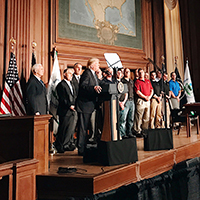
Trump Dumps Fed Climate Programs
View the page for this story
TRUMP DUMPS FED CLIMATE PROGRAMS: The Trump administration issued an Executive Order that it claims will increase America’s energy independence and revive the coal industry. Critics say the measures that include killing Obama’s signature Clean Power Plan to curb carbon emissions won’t bring back coal jobs, but will set America on a perilous path that encourages dangerous global warming. Living on Earth Host Steve Curwood reports from Capitol Hill. (12:40)
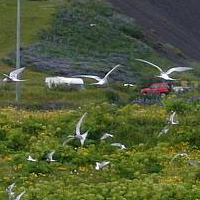
Science Note: Cooling the Arctic with Guano
/ Don LymanView the page for this story
In this week’s note on emerging science, Living on Earth’s Don Lyman uncovers new research that links ammonia from seabird guano to atmospheric cooling in the Arctic. (02:00)
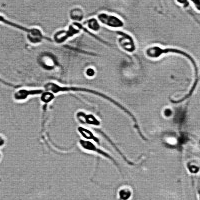
Chemicals Reduce Sperm Counts
View the page for this story
Fifteen years ago, over half of potential sperm donors in Hunan Province, China, met quality standards. Now, only 18% do, a decline blamed on endocrine disrupting chemicals. Host Steve Curwood discusses the implications of this new study with epidemiologist Shanna Swan, of the Icahn School of Medicine at Mount Sinai. (10:55)
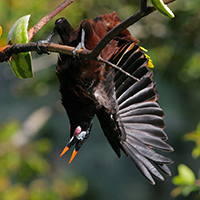
BirdNote: “The Golden Pendulum”: Montezuma Oropendola
/ Michael SteinView the page for this story
BIRDNOTE: “THE GOLDEN PENDULUM”: MONTEZUMA OROPENDOLA: The unusual gurgling song and firecracker pop of the Montezuma Oropendola accompanies an acrobatic show of its golden feathers. BirdNote’s Michael Stein says the Central American bird’s trick of hanging upside down is the source of its Spanish name, “Oropendola,” or "golden pendulum." (02:00)
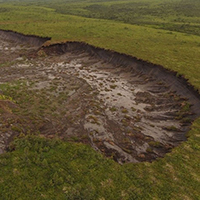
Watching the Arctic Melt
View the page for this story
WATCHING THE ARCTIC MELT: Permafrost is thawing fast across the world’s polar regions due to global warming. A recent study maps the extent of this thaw over a million square kilometers in northern Canada, and provides insight into likely landscape changes expected soon. Host Steve Curwood spoke to study co-author, environmental scientist Trevor Lantz of the University of Victoria in British Columbia about mapping these disturbances and how ice deposits that melt can cause the ground to collapse. (08:00)
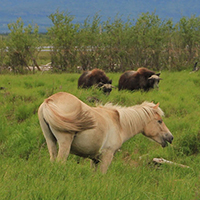
A Way to Refreeze the Arctic
/ Jenni DoeringView the page for this story
Russian scientists Sergey and Nikita Zimov have a plan to slow the thawing of the Siberian permafrost, by bringing back grazing animals to a swath of land they call Pleistocene Park. They argue trampling herds of bison, musk ox, reindeer, moose and even, perhaps, woolly mammoths compacted the snow and lowered the permafrost temperature. Living on Earth’s Jenni Doering reports on the plausibility of the Zimovs’ experiment and how it caught the attention of an American filmmaker. (07:35)
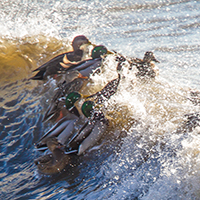
Mallards Brave New England’s Winter Surf
/ Mark Seth LenderView the page for this story
New England winters can be harsh even in a good year – yet some mallard ducks brave the cold and pounding surf at the shoreline. Living on Earth’s Resident Explorer Mark Seth Lender watches their struggles against wild wind and water. (02:45)
Show Credits and Funders
Show Transcript
HOST: Steve Curwood
GUESTS: Shanna Swan, Trevor Lantz, Mark Seth Lender
REPORTERS: Don Lyman, Michael Stein, Jenni Doering
THEME]
CURWOOD: From Public Radio International, this is Living on Earth.
[THEME]
CURWOOD: I'm Steve Curwood. Donald Trump’s order seeking to overturn Barack Obama’s climate protection program may please the coal industry, but it’s run into a storm of criticism.
MARKEY: President Trump didn’t issue an executive order. He issued a declaration of war on Americans’ climate leadership and our clean energy future. This executive order isn’t about energy security. It is about climate denial.
CURWOOD: Also, how chemicals that disrupt the hormone system can reduce to fertility and more.
SWAN: Those men who have poor reproduction function, say low sperm count, several studies have now shown that their overall mortality is higher. In other words, they will die earlier.
CURWOOD: The dangers endocrine disruptors pose for men’s health. We’ll have those stories and more, this week on Living on Earth. Stick around.
[NEWSBREAK MUSIC: Boards Of Canada “Zoetrope” from “In A Beautiful Place Out In The Country” (Warp Records 2000)]
[THEME]
Trump Dumps Fed Climate Programs
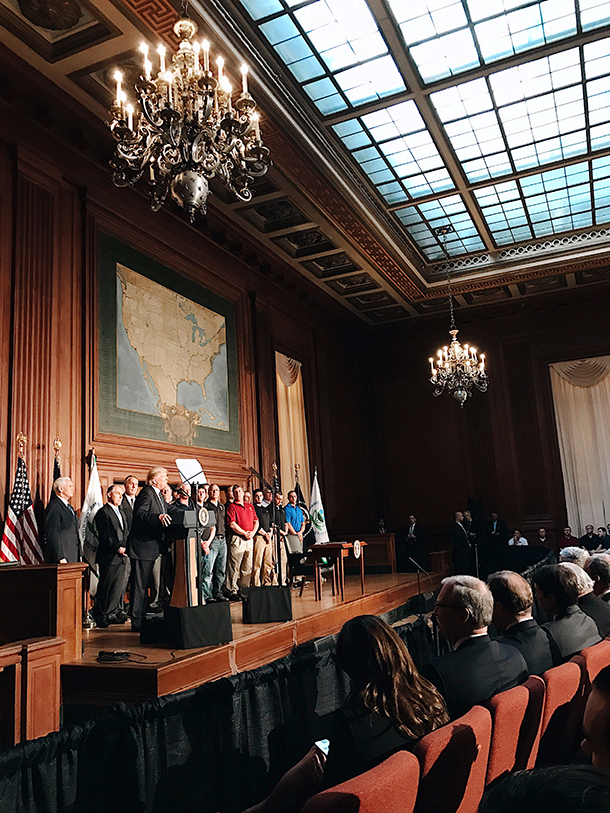
President Trump signing the Energy Independence Executive Order alongside a group of coal miners, Vice President Mike Pence and EPA Administrator Scott Pruitt. (Photo: Official White House Photo by Jonathan Gallegos)
CURWOOD: From PRI, and the University of Massachusetts, Boston, this is Living on Earth. I’m Steve Curwood, in Washington, DC.
Despite an untimely late snowfall and freeze, this city’s famed cherry blossoms were in full bloom March 28.
[CROWD CHANTING “We are unstoppable, another world is possible]
CURWOOD: Environmental demonstrators were outside the White House and the EPA building protesting the latest move by President Trump to roll back climate protection rules. Meanwhile, a phalanx of motorcades from the White House and Capitol Hill converged early in the afternoon at the headquarters of the EPA. Climate change and disruption have been a major focus for the agency for years, but the climate went unmentioned by Mr. Trump and the members of his team, as the President took to the stage to sign his executive order to create energy independence. Instead, according to Energy Secretary Rick Perry, who spoke first, the order was simply about basic pollution.
PERRY: The president with his signature on that executive order is going to set in motion government reforms designed to continue promoting clean air and water for the American people.
CURWOOD: EPA administrator Scott Pruitt defined it a bit more broadly, but he still said nothing about provisions that effectively gut the Obama Administration’s executive initiatives to fight climate change.
PRUITT: The president, by his signature today, is rejecting the narrative that this country cannot be both pro-energy and pro-environment. We have done that throughout our history. We can actually achieve good jobs, good growth and pro energy polices at the same time as protecting our environment.
CURWOOD: But while the speeches may have been short on specifics, the optics were clear. A dozen burly coal miners were up on the stage with the dignitaries, to emphasize that America is abundant with coal. Trouble is, coal is abundant with carbon, making it the dirtiest fuel in terms of generating global-warming gases. And before scrubbers were installed in power plants starting three decades ago, the fine particle pollutants from coal were blamed for as many as 30,000 early deaths a year. Whether it’s carbon, or particulates or mercury or sulfur pollution, the EPA has a congressional mandate to regulate it. But interior Secretary Ryan Zinke was dismissive of efforts by the Obama Administration to reduce the climate and health risks of coal.
ZINKE: You know, our nation can’t run on pixie dust and hope, and the last eight years showed that.
CURWOOD: America imports no coal. In fact, we export vast amounts of very dirty, low-quality coal mined on western public lands and Secretary Zinke, a former Navy Seal commander, rather likes that.
ZINKE: Why is energy independence necessary? Well three things: one is the environment. I’m the steward of our nation’s majesty. I can tell you as a former commander, it is better to produce energy here under reasonable regulation than watch it get produced overseas with none. And I’ve seen it in Africa, in the Middle East. Secondly, is jobs. Jobs matter. Hard-working Americans deserve to have a future. And, lastly, national security. The world is safer when America is strong. And our strength relies on energy.
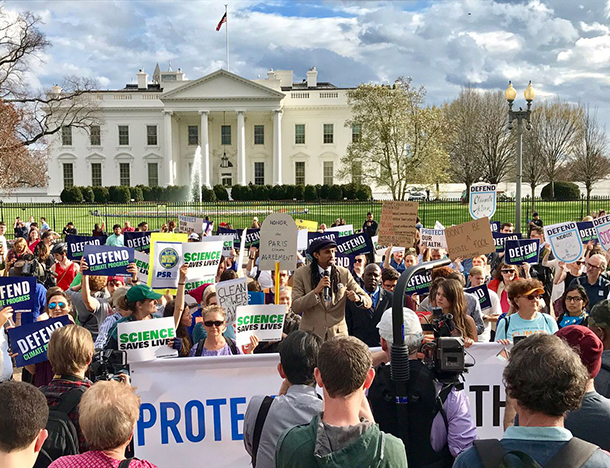
A crowd organized outside the White House hours after the order was signed to curtail federal climate action. (Photo: People’s Climate March)
CURWOOD: But cheap natural gas now generates as much electricity as coal in the US, and coal mines continue to close. Vice President Mike Pence says that’s a matter of concern in West Virginia.
PENCE: Over 130 mines have been shut down since 2009. As today's actions demonstrate, under president Donald Trump, those days are over because the war on coal is over. [APPLAUSE]
CURWOOD: Among those applauding warmly were Senators from the coal states of West Virginia and Wyoming and the CEO of the Murray Energy Corporation, the largest US underground coal mining company with more than a billion and a half dollars-worth of coal reserves in the ground.
TRUMP: That is what this is all about: Bringing back our jobs, bringing back our dreams, and making America wealthy again.
CURWOOD: Mr. Trump’s words pleased the crowd, but he didn’t acknowledge that the coal industry has lost only about 20,000 jobs over the past decade. Meanwhile the solar power sector created 35,000 new jobs, in one year alone – 2015 - though admittedly not in the coal country of West Virginia, Kentucky, Ohio and Pennsylvania, states critical for his election victory.
TRUMP: I want to acknowledge the truly amazing people behind me on this stage, our incredible coal miners. [APPLAUSE] We love our coal miners. [APPLAUSE]
CURWOOD: The president gestured to the miners standing on the stage, their jeans, khakis, and polo shirts giving a down-home, yet determined face to the abstract concepts of regulation and economic trends.
TRUMP: [APPLAUSE] They’re tough looking guys, too. I’ll tell you what. You’re not going to mess around with this group, right. All right. Thank you, fellas. [APPLAUSE]
CURWOOD: President Trump swung into his gift of storytelling.
TRUMP: The miners told me about the attacks on their jobs and their livelihoods. They told me about the efforts to shut down their mines, their communities, and their very way of life. I made them this promise: We will put our miners back to work. [APPLAUSE] We've already eliminated a devastating anti-coal regulation, but that was just the beginning.
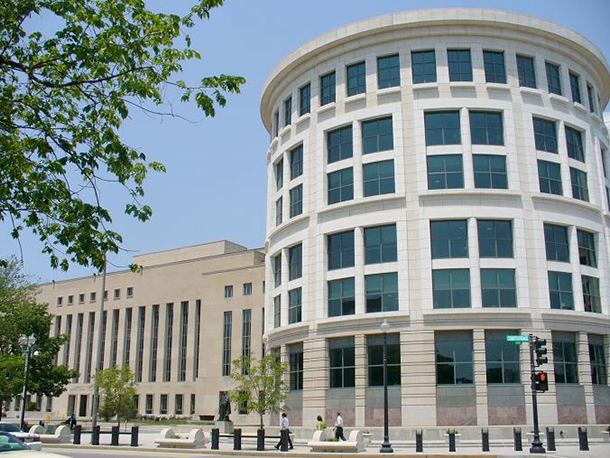
The Clean Power Plan is currently under review by the DC Circuit Court of Appeals after multiple allegations that it goes beyond the constitutional powers of the federal government. (Photo: Michael Weinberg, Flickr CC BY 2.0)
Today, I'm taking bold action to follow through on that promise. My administration is putting an end to the war on coal. Gonna have clean coal, really clean coal. With today’s executive action, I am taking historic steps to lift the restrictions on American energy, to reverse government intrusion, and to cancel job-killing regulations. [APPLAUSE] And, by the way, regulations not only in this industry, but in every industry. We're doing them by the thousands, every industry. And we're going to have safety. We're going to have clean water. We're going to have clean air. But so many are unnecessary, and so many are job-killing. We're getting rid of the bad ones.
One after another, we’re keeping our promises and putting power back into the hands of the people. First, today’s energy independence action calls for an immediate reevaluation of the so-called Clean Power Plan. [APPLAUSE] Perhaps no single regulation threatens our miners, energy workers, and companies more than this crushing attack on American industry.
Second, we are lifting the ban on federal leasing for coal production. Third, we are lifting job-killing restrictions on the production of oil, natural gas, clean coal, and shale energy.
And finally, we are returning power to the states, where that power belongs. States and local communities know what is best for them. They understand it. They get it. They’ve been doing it for a long time. It was taken away from them, and not handled well, and they are the ones that we should now, and will now, empower to decide.
CURWOOD: President Trump has ordered the executive branch to stop considering climate change when it comes to issuing most regulations and operating the federal bureaucracy. His executive order also wipes out a program to help cities and states build resilience to climate change-related, extreme weather events, such as storm surges, floods and droughts. Now, it’s more complicated for the President to revise existing agency rules, such as those governing methane emissions that the oil and gas industry finds burdensome. And even as Mr. Trump was leaving the stage, EPA lawyers were already filing briefs at the DC Court of Appeals. The court is considering a case against president Obama’s signature program, the Clean Power Plan to control carbon pollution which hits coal power generation particularly hard. President Trump’s EPA wants to weaken or eliminate that rule. But even if the appeals court goes along it could take years to unwind the Clean Power plan, given the US Supreme Court ruling that carbon dioxide is a pollutant. And though Mr. Trump’s executive order is focused almost completely on climate change, those words were never mentioned.
[SOUNDS OF TRAFFIC ON CAPITOL HILL]
It was a different case up on Capitol Hill. Five Democratic senators - Tom Carper of Delaware, Ben Cardin of Maryland, Sheldon Whitehouse of Rhode Island, Edward Markey of Massachusetts, and Jeff Merkley of Oregon - briefed the press at the same time as Mr. Trump presented his executive order just blocks away down Pennsylvania Ave at the EPA. Here’s Senator Merkley.
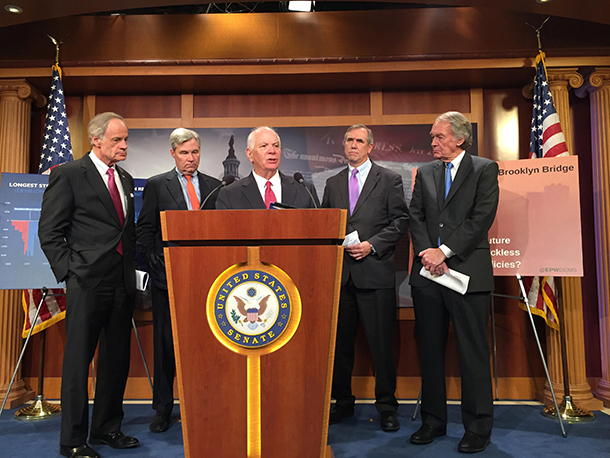
Democratic Senators (left to right) Tom Carper, DE, Sheldon Whitehouse RI, Ben Cardin, MD, Jeff Merkley OR, and Edward Markey, MA assembled on Capitol Hill for a press conference condemning the President's executive action.(Photo: Jaime Kaiser)
MERKLEY: Thank you, I am honored to be here with this group of five senators who are climate champions, who are fighting for clean water and for clean air and specifically to take on the carbon pollution that’s having such an impact. Carbon pollution is destroying the resources of rural America. It is destroying our forests, our farming and our fishing. The fire season in Oregon is now two months longer than it was decades ago. The streams are warmer and smaller because of the smaller snowpack in the mountains. Over on the coast, we have the difficulty of oysters being unable to reproduce correctly because the water is so much more acidic because the burning of fossil fuels has become carbon dioxide, has become carbonic acid and it is making it very hard for shellfish to start their life. Not to mention, coral reefs around the world, 80 percent of the Great Barrier Reef, dying in the last few years. The list goes on and on and on, wherever you look. So that group of four that is assembled across the city is standing up and saying we are going to try to increase the destruction of our forests, increase the destruction of our farming with less irrigation water, increase the destruction of our fishing. And we are here to say, “No.”
CURWOOD: And though the President called his declaration an executive order to create energy independence, Senator Markey argued it deserved a different name.
MARKEY: President Trump didn’t issue an executive order. He issued a declaration of war on Americans’ climate leadership and our clean energy future. This executive order isn’t about energy security. It is about climate denial. It is the wholesale dismantling of every policy and rule that President Obama put on the books to cut carbon pollution and address climate change. This executive order is one massive giveaway to big coal and oil corporations at the expense of decades of progress on climate change, clean energy, and public health protections.
CURWOOD: Outside the Capitol, there were more cherry blossoms blooming, along with redbuds and magnolias still looking lovely, and if plants have personality, they seemed to defy the wild gyrations in the weather this year. And that would make them rather like people. A recent survey showed a majority of voters in every congressional district say humans are upsetting climate stability, but only a small minority says it has a direct personal impact. And that denial means few voters marked their ballots with an eye towards climate concerns.
Related links:
- Full text of the Executive Order
- Trump signing the Executive Order at the EPA
- Entire Democrat Senate Press Conference
[MUSIC: Tommy Dorsey and His Orchestra, “Smoke Gets In Your Eyes” on The Best of Jerome Kern, Kern/Harburg, Chestnut Records]
CURWOOD: Coming up, a surprising biological way to cool the atmosphere. Stay tuned to Living on Earth.
ANNOUNCER: Support for Living on Earth comes from the Gordon and Betty Moore Foundation, and from a friend of Sailors for the Sea, working with boaters to restore ocean health.
[CUTAWAY MUSIC: Ron Block, “What Wondrous Love Is This” on Walking Song, traditional Appalachian, Rounder Records]
Science Note: Cooling the Arctic with Guano
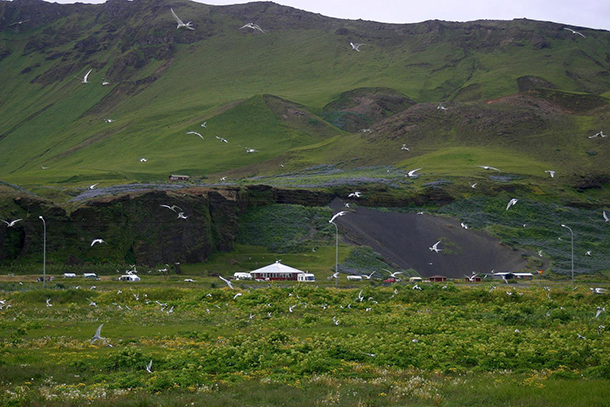
http://www.audubon.org/magazine/january-february-2016/sitting-ducks-why-millions-arctic
CURWOOD: It’s Living on Earth, I’m Steve Curwood. Just ahead, chemicals and a huge drop in human fertility. But first this cool note on emerging science from Don Lyman.
[SCIENCE NOTE THEME]
LYMAN: For millions of years, seabirds breeding on cliffs and islands deposited guano, creating a valuable source of fertilizer for farmers. And now Canadian scientists have discovered that seabird poop also helps to cool the Arctic. In a recently published journal article, researchers from Dalhousie University and Alberta Environment and Parks report that the gas ammonia is surprisingly abundant in the Arctic air. They identify the source as guano produced by tens of millions of birds that breed in the Arctic each summer.
Bacteria that feed on the birds’ feces release about 40,000 metric tons of ammonia annually, the scientists reported. When the ammonia rises into the atmosphere it reacts with sulfuric acid and water to create tiny particles that form the nucleus for increased numbers of small cloud droplets.
Since clouds made up of smaller droplets have more surface area than clouds that consist of fewer larger droplets, the researchers say the clouds of smaller droplets reflect more sunlight back into space. This causes one-half to one watt per square meter of cooling during the Arctic summer, helping to offset some of the average 1.6 watts of warming per square meter that human-produced carbon dioxide causes.
The scientists admit that this bird poop produces only a modest cooling effect, given that the natural greenhouse processes that help keep the earth habitable cause as much as 150 watts of atmospheric warming per square meter. But they argue that understanding the effects might help future researchers better predict how the Arctic will fare as climate change progresses.
That’s this week’s note on emerging science. I’m Don Lyman.
Related links:
- Science Magazine: “How bird poop helps cool the Arctic”
- NOAA: Arctic Seabirds
- Audubon: “Sitting Ducks: Why Millions of Arctic Seabirds Are in Danger”
[SCIENCE NOTE THEME]
Chemicals Reduce Sperm Counts
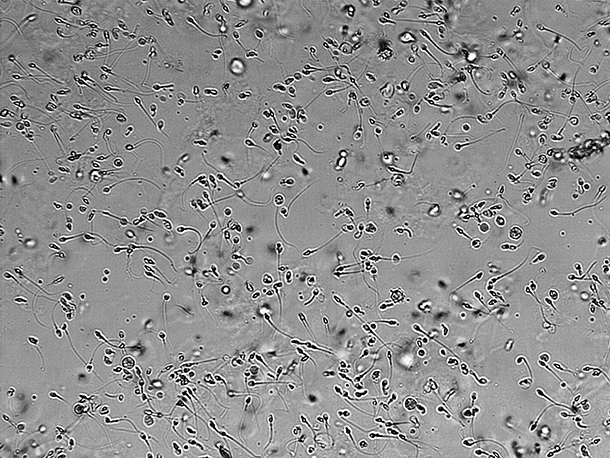
Human sperm counts continue to decline, says a new study. (Photo: Doruk Salancı, Wikimedia Commons CC BY-SA 3.0)
CURWOOD: More than a half century ago Rachel Carson sounded the alarm about the effects that a chemical could have on reproduction. In "Silent Spring" she was concerned about DDT’s impact on thinning of the eggs of birds such as eagles and brown pelicans.
Well, today researchers in Taiwan are sounding the alarm about chemicals that are sharply reducing human sperm counts there. These chemicals are known as endocrine disruptors, and they can mimic or interfere with the natural hormones that control growth and a body’s immune system, neurological functioning, and fertility.
Studies from Denmark a quarter century ago showed that sperm counts had declined by about half from a generation earlier. Now the Taiwanese team has found that semen quantity and quality, sampled from sperm donors, have deteriorated even more in recent years, a change that is linked to endocrine disrupting chemicals. And epidemiologist Shanna Swan says these chemicals are everywhere.

Mounting evidence suggests there is a link between endocrine disrupting chemicals and the continuing decline in male fertility and reproductive health in different countries around the world. (Photo: Stephane Moussie, Flickr CC BY 2.0)
SWAN: Chemicals that make plastics soft which are phthalates or chemicals that make plastics hard like Bisphenol A, or chemicals that are flame retardants, chemicals that are in Teflon, and so on, pesticides. Many, many classes of chemicals that are in our daily lives all the time.
CURWOOD: Dr. Swan studies endocrine disruptors and their effects at the Icahn School of Medicine at Mount Sinai, and years ago I talked with her about the Danish semen quality studies. So, I called her up again to relate the new study from China to the earlier research.
SWAN: So, the study you talked about from many years ago was a study, actually 25 years ago, 1992, by Elizabeth Carlsen who was working with Niels Skakkebaek and that was a, I would say, a landmark study. And what they said in that study was that sperm counts had declined 50 percent in the 50 years prior to that study, and this was pretty dramatic. There was nothing said about the cause of that decline at that time, but just that this was a considerable concern. Now, 25 years later, we're seeing that this has not gone away despite all the arguments to the contrary - People who had not accepted that initial finding. And we are still asking why, but we have increasing evidence that chemicals in the environment play a significant part in that decline, if not producing it.
CURWOOD: And just how much of a reduction is this Taiwanese study suggesting we're experiencing now?
SWAN: Well, the Taiwanese study, I believe, said that something like only 20 percent of men who were previously suitable for their sperm donor bank would make it in now. There's a similar study actually from Israel that found almost the same numbers. And, because you have to keep the quality high to bring people in for assisted reproduction, if we see the quality going down, and we see the quality going down because the WHO standards for western normal sperm has gotten lower and lower over the years…So, I would say it's probably not just China or Israel or Denmark...it's probably many places in the world, although probably not all. And it's probably not equality a problem in countries in the world, but it is a problem.

Male reproductive health can be compromised both in utero -- a permanent change, involving the structure of the reproductive organs – as well as in adulthood, when sperm quality and quantity can be impacted by various factors. (Photo: Carol Lara, Flickr CC BY 2.0)
CURWOOD: And what do you think the odds are that it's affecting the quality of sperm here in the United States.
SWAN: I think that's pretty certain that semen quality is going down in the United States. We have many US studies. I personally have been involved in several of them. I would say we have very good evidence that male reproductive health, not just semen quality by the way, is in trouble, and this has consequences, not just for the ability to have a child, but it also impacts the health of the man. So, I think this is like a “canary in the coal mine,” that it's indicating there is a problem with male health, focusing on reproductive health but having impacts on the entire health of the male.
CURWOOD: What problems are you thinking of?
SWAN: Well, the immediately related problems are those that are linked to the function to testes. There's a lot of evidence now that, when the male is in utero, the development of the testes governs a lot of what happens in the reproductive tract, and when you have problems with that testicular development, you can get in a whole array of things which have been called now the Testicular Disgenesis Syndrome. It includes low sperm count, infertility, testicular cancer, and various general defects. One of them is undescended testicles, another one is a condition where the opening of the urethera is not where it should be, and all of these have to do with the development of the testes at the right time in pregnancy, which requires the right amount of testosterone. So they're all linked to interference with testersterone production, which is a hormone produced by the endocrine system, and which can be disrupted by endocrine disruptors. So it kind of ties all together.
Those men who have poor reproductive function, say low sperm count, several studies have now shown that their overall mortality is higher. In other words, they will die earlier.
CURWOOD: What's the evidence that chemicals are causing this?

Common household items including Teflon-coated pots and pans and sunscreens can contain endocrine disruptors. (Photo: Your Best Digs, Flickr CC BY 2.0)
SWAN: So, that's really a great question and one that I and many, many, many people are looking at. So, you can interfere in two ways. You can interfere with the development in utero which is a permanent change. You can interfere with the adult function which is transient, a temporary, change.
So, for example, there's a famous story of men who were growing pineapples in Hawaii and in Israel, using a chemical pesticide called DBCP, Dibromochloropropane, and it turned out, when the wives got together and talked about it, they were not getting pregnant. When the men were tested, they had no sperm. Zero sperm. Azoospermia. OK? Very severe adult interference, OK? They were taken off that job. The chemical was taken away, and their sperm function came back gradually, and after a while, it was restored. So, that's a pesticide that interferes with sperm function in adulthood. Lead does that. X-ray does that. Many chemicals can interfere at high doses to adult function.
CURWOOD: What do you think we've seen in terms of regulatory action to clean up these chemicals in our environment?
SWAN: I'm somewhat encouraged by the fact that levels of phthalates that we were most concerned about and wrote about in 2005, those chemicals have gone down in the urine of pregnant women, about 50 percent, which is really, really encouraging.
CURWOOD: Indeed.
SWAN: Which means that there was some government action, although not for exposure to pregnancy. It was for children's toys, but OK. There was some government action. There was a lot of consumer concern, and I'm sure many manufacturers took the steps to reduce these chemicals in their products. So, that is excellent.

Plastics in many children’s toys contain Bisphenol A, to make them hard; and/or phthalates, to make them soft. Both of these chemicals are endocrine disruptors. (Photo: Chris Bickham, Flickr CC BY 2.0)
The downside is that, for these chemicals, these phthalates and also for Bisphenol A, as those things have been taken out, you buy something “Bisphenol-free,” then it's going to have Bisphenol F and Bisphenol S, which are substitutes, which now we learn have similar action to Bisphenol A. And we see that with substitutes with phthalates too.
So, it's kind of a, you know, it's a moving target. So, we say, “OK, we'll show you that these things are harmful,” and we do that, and we convince people to take them out of products, and then there are substitutes are put in which are not tested. So, I'd say the progress has been very slow, but not negligent. We have made progress.
CURWOOD: So, what can people do on their own, then, to reduce exposure to endocrine disrupting chemicals?
SWAN: I'll tell you a few things. One problem is, though, that they’re more expensive. So if I say, “Eat organic. Eat unprocessed food,” there are segments of the population that can't do that. First of all, they might not have fresh food nearby. They might not have the money to pay for organic food, which is always more expensive. So, I can say, “Yes, I would recommend eating organic, eating unprocessed food, because processing does introduce endocrine disruptors into food. We know that.” Ideally, you would go to a farmer's market. You would buy organic produce. You would cook it yourself, and you would eat it right away. You wouldn't store it in plastic. You wouldn't ship in plastic, and so on. By the way, looking at the recycling codes on the bottoms of bottles and products in your house, there's a helpful thing that says, “Four, five, one, and two, all the rest are bad for you”, has to do with the recycling codes. So, recycling codes four, five, one and two certainly not as bad as the others.
You would be careful about what you put on your body, the sunscreens, the personal care products all contain endocrine disruptors. If you weren't sure, I would say, you go to Environmental Working Group's website and put in a product, and they will tell you how many endocrine disruptors there are in there and which ones are preferable. And I do that, and I recommend it to my kids and my students. I would say, I don't cook in Teflon. I try to look at the chemical burdens of products that come into my home, and to the extent that we are told about these – You can't, by the way, on a can see the phthalates that are in the product. You won't know that. So that's very difficult. That's why I'm saying you should eat unprocessed foods to the extent possible.

Dr. Shanna Swan is an epidemiologist at the Icahn School of Medicine at Mount Sinai. (Photo: Dr. Shanna Swan)
CURWOOD: Dr. Swan, how scary is all of this, this rather precipitous drop in sperm counts, the other effects of chemicals on our endocrine systems. Just how much trouble are we in?
SWAN: I personally think it's a very serious problem, which is why I've spent the last 20 years trying to understand it and help people minimize it. I think that it's one of the major challenges that we are facing as a society, and it's something that people are not taking seriously enough.
CURWOOD: Shanna Swan is a Professor of Environmental Medicine and Public Health at the Icahn School of Medicine at Mt. Sinai. Thanks so much for taking the time with us today, Dr. Swan.
SWAN: It was a pleasure, Steve. Nice to talk to you again.
Related links:
- China Post: Sperm count among male donors in Taiwan on the decline: study
- Environmental Working Group list of endocrine disruptors
- Our 2015 conversation with Shanna Swan on phthalates and hormone disruption
- LOE: “Hormone Disruptors Linked to Genital Changes and Sexual Preference”
- NYTimes: “Are Your Sperm in Trouble?”
[MUX - BIRDNOTE® THEME]
BirdNote: “The Golden Pendulum”: Montezuma Oropendola

/content/2017-03-31/t-BIRDNOTE-Montezuma-Oropendola-displaying---Tristanba.jpg /content/2017-03-31/BIRDNOTE-Montezuma-Oropendola-displaying---Tristanba.jpg
CURWOOD: To those of us who live in temperate climes, some tropical birds seem particularly unusual and exotic. Michael Stein introduces us to one of them in today’s BirdNote – the Golden Pendulum.
http://birdnote.org/show/montezuma-oropendola-golden-pendulum
BirdNote®
The Golden Pendulum – Montezuma Oropendola
STEIN: On a winter morning in the Central American tropics, the sun rises…
[Montezuma Oropendola song]
In a clearing, surrounded by dense forest, stand the ruins of a Mayan city.
And on the warming air, floats an intriguing song…
[Montezuma Oropendola song, repeated, without firecracker notes]
Perched beside its nest is the author of those gurgling tones. A Montezuma Oropendola. He sings again, this time with a sound like the pop of firecrackers.
[Montezuma Oropendola song, with firecracker notes]
The 20-inch-tall male Montezuma Oropendola is feathered in rich chestnut brown. He's an oversized cousin of orioles, wielding a sharp spike of a bill tipped in red. As his song display begins, he grasps a branch in his feet, bows forward and then hangs completely upside down, wings fluttering. His long tail becomes clearly visible, bright yellow, pointing upwards.
Our Oropendola's now suspended head downward, swinging by his feet, singing.
His tail describes a golden pendulum – the source of his name in Spanish – oropendola.
[Montezuma Oropendola song, with firecracker notes]
I’m Michael Stein.
###
Written by Bob Sundstrom
Call of the Montezuma Oropendola provided by The Macaulay Library of Natural Sounds at the Cornell Lab of Ornithology, Ithaca, New York. Recorded by C. Duncan.
BirdNote’s theme music was composed and played by Nancy Rumbel and John Kessler.
Producer: John Kessler
Executive Producer: Chris Peterson
© 2005-2017 Tune In to Nature.org March 2017 Narrator: Michael Stein
http://birdnote.org/show/montezuma-oropendola-golden-pendulum
CURWOOD: And you can see pictures of this remarkably tuneful bird at our website LOE.org.
Related links:
- Listen on the BirdNote website
- Watch the unusual display of the Montezuma Oropendola
- More about the Montezuma Oropendola from the Cornell Lab of Ornithology
[MUSIC: Marcus Robert, “Foggy Day” on Gershwin For Lovers, George Gershwin, Columbia Records]
CURWOOD: You can hear our program anytime on our website, or get an audio download. The address is LOE.org. That's LOE.org. There you’ll also find pictures and more information about our stories.
And we’d like to hear from you.You can reach us at comments@LOE.org. Once again, comments@LOE.org. Our postal address is PO Box 990007, Boston, Massachusetts, 02199.
And you can call our listener line, at 800-218-9988. That's 800-218-9988.
[MUSIC: Marcus Robert, “Foggy Day” on Gershwin For Lovers, George Gershwin, Columbia Records]
Coming up...an intriguing new proposal to refreeze the Arctic. That’s just ahead here on Living on Earth. Stay tuned.
ANNOUNCER: Funding for Living on Earth comes from you our listeners, and United Technologies - combining passion for science with engineering to create solutions designed for sustainability in the aerospace, food refrigeration and building industries. UTC companies such as Otis, Carrier, Pratt & Whitney and UTC Aerospace Systems are helping to move the world forward.
This is PRI, Public Radio International.
[MUSIC: Marcus Robert, “Foggy Day” on Gershwin For Lovers, George Gershwin, Columbia Records]
Watching the Arctic Melt

A thaw slump shapes the terrain on the Peel Plateau in the Canadian Northwest Territories (Photo: Jon Tunnicliffe)
CURWOOD: It’s Living on Earth, I’m Steve Curwood.
Permafrost, the subsurface soil that remains frozen year-round in the Earth’s polar regions, is thawing due to climate change. This fact is well known, but less is understood about the scope of the thaw and how it might change the global landscape. A new study maps disturbances in the permafrost over a large swath of Canada’s northwest territory, in particular, what are called “thaw slumps”, areas where melting ice causes the ground above it to collapse. One of the authors of the paper, Trevor Lantz, is an Associate Professor of Environmental Studies at the University of Victoria in British Columbia, Canada, and he joins us now.
Trevor, welcome to Living on Earth.
LANTZ: Thanks for having me.
CURWOOD: So, tell me first, what happens when permafrost starts to melt?
LANTZ: Well, the research that my lab here at the University of Victoria is particularly interested in is permafrost thaw in ice-rich permafrost environments. So, these are parts of the permafrost landscape that have large volumes of frozen water in them, and these areas are particularly vulnerable to warming ground temperatures, which is something that we're seeing across the circumpolar in response to increases in air temperature caused by human fossil use. And one of the kinds of permafrost disturbances that we've been working a lot on are features called “thaw slumps,” and so these are permafrost disturbances that occur in hilly terrain, which is rich in ice. And I really want to emphasize the ice-rice part of this because we're talking about hill slopes that are between 60 and 90 percent ice by volume. And so, when an area like this thaws, you know, the materials that thaw turn into a muddy slurry, and they create an exposure of what we call a “head wall,” and, over time, those exposed sediments continue to thaw and flow downhill, and the disturbances grow and eat their way back up into the landscape. And over time these features can come to occupy quite large areas of terrain. So a typical slump, you know, is between five and 15 acres, but we are starting to see now, much, much larger disturbances. So, some of the features we study are upwards of 75 acres. This is roughly the size of a large shopping mall, like a mega mall.
CURWOOD: So, looking at your research there about permafrost thaw in Canada, how large of an area is this permafrost melting?

A thaw slump on Banks Island in the Canadian Northwest Territories. When thaw slumps gather sediment and flow downhill, the movement of sediment can contaminate lakes and streams. (Photo: Emily Cameron)
LANTZ: Yeah, so up until quite recently we've focused on these disturbances and different forms of permafrost thaw in relatively small areas, and what's unique about our, our recent study is that we mapped areas that are impacted by permafrost thaw across a pretty massive portion of Northern Canada, so, about a million square kilometers. This is I guess about a third of the size of the continental US, and within this area about 20 percent of that landscape is impacted by permafrost thaw. So, that's an area that's a fair bit larger than the state of California.
CURWOOD: So, talk to me a bit about your methodology and how you gathered images of all this permafrost melting.
LANTZ: Yeah, one of the fun things about this recent study is that, because we were keen to map such a large area, we actually enlisted the help of a number of mappers that worked for different government agencies in the Northwest Territories of Canada, and it's the largest area, you know, that's been mapped in this way, and it provides some really unique insights into what's going on.
One of the things that's particularly exciting and surprising, I guess, about our map is that it shows that the distribution of these areas that are impacted by thaw slumps correlates almost perfectly with the position of the Laurentide ice sheet 15,000 years ago. So, this is the continental ice sheet that covered almost all of Canada as recently as about 13,000 ago. So, the disturbances that we're seeing follow the margin of where that ice sheet was 15,000 years ago, and what that tells us is that ice that was created in these environments, as the glacier was receding, or glacier ice itself, was preserved by cold climate and permafrost, and that ice has been preserved for tens of thousands of years and is still sitting in the northern landscapes, and it gives us a sense for the potential change that that will occur in these places. So, the point that we make in the paper is essentially that Arctic landscapes have not fully undergone deglaciation in the same way that southern Canadian or northern US landscapes have.
CURWOOD: Now, you they say it's fun to work on this as a collaborating researcher, but it also points to something pretty ominous, it seems. How will the Canadian landscape be affected by this kind of melting, the increased volume of sediment in lakes and rivers?
LANTZ: Yeah, well, one of the communities that we work in the north are particularly concerned about are the impacts that these disturbances are having on ecosystems and the plants and animals in these environments, and so there's ongoing research that we're involved in and other folks are working on to clarify the impacts that these things are having. In aquatic environments, these disturbances can mobilize huge volumes of sediment. So, one of the features that we've been studying, the large thaw slumps near a community called Fort McPherson, Northwest Territories, we estimate that it mobilizes about 650,000 cubic yards of sediment on an annual basis, and so this material can move into adjacent creek valleys and totally infill those creek valleys. It can also move into the lakes, rivers, and streams where it alters water chemistry, increases the turbidity of those waters and has an effect on food webs that decreases the abundance and diversity of aquatic macroinvertabrates which likely cascades to impact fish. So, we're working to understand the fine-scale effects of these kinds of changes on northern communities and northern livelihoods; so, how do landscape changes like this affect people's ability to hunt and fish and travel in northern landscapes.
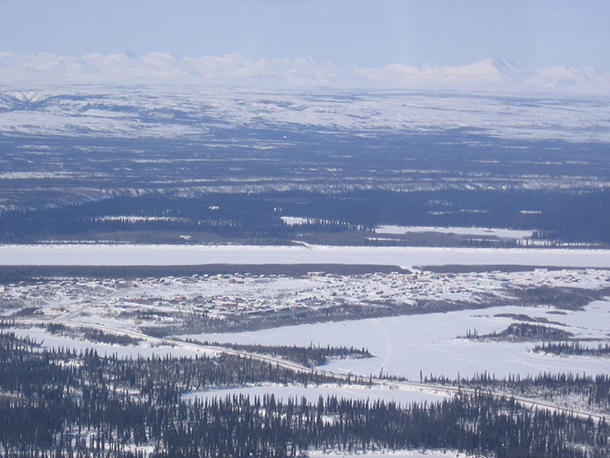
An aerial view of Fort McPherson, Northwest Territories, one of the communities that may be affected by thaw slumps in the surrounding environment. (Photo: Mattcatpurple, Flickr CC BY-SA 2.0)
CURWOOD: People often say that permafrost holds roughly twice the amount of carbon than is found in the atmosphere. What does your study signal in terms of potential release of carbon into the atmosphere?
LANTZ: Yeah, what the consensus around permafrost carbon is that global warming will slowly release those carbon stocks, and so that there isn't this catastrophic potential for a doubling for CO2 in the near term, because gradual warming of those soils will slowly liberate this permafrost carbon stock. The kinds of disturbances that we've been talking about, things like thaw slumps that can really rapidly mobilize permafrost carbon are a different story, and they don't cover, you know, all of the circumpolar north, but they do impact relatively large areas. So, one of the motivations for this work was to better understand how much of the landscape these disturbances impact.
So, I mentioned that this is the broadest scale effort to map these disturbances, and it really only covers half of northern Canada. So, there's ongoing initiatives to better understand the distribution of these kinds of features across the circumpolar north, and that's the information that we really need to better constrain global models and better understand the contribution that rapid – you know, sort of in the next decades -- permafrost thaw will have on the climate system.
The really compelling reason for me to continue to work in the Arctic is because, one, it provides a glimpse into the future of the rest of the planet where similar warming will occur within the decades ahead, but Arctic ecosystems also have a disproportionate effect on the global climate system. So, we need to understand what's happening there to understand how the global climate is going to respond.
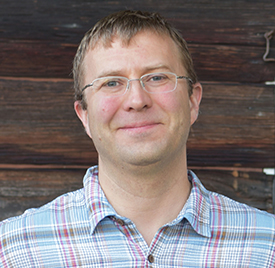
Trevor Lantz is an Associate Professor of Environmental Studies at the University of Victoria in British Columbia and has been researching permafrost in the Arctic for 15 years. (Photo: Kendra Holt)
CURWOOD: What are the solutions here? I suppose the ultimate solution is the refreeze the Arctic. How might we do that?
LANTZ: Well, many of the processes that we've been talking about have already been initiated. So, we're talking about slowing the amount of warming that continues to occur, so it's really a human mitigation issue, stabilizing the amount of CO2 that's in the atmosphere. You know, even if that could happen tomorrow, we're going to continue to see the impacts of these disturbances and the impacts of increasing temperature on Arctic ecosystems for decades-to-centuries to come. The question is, how large will those impacts be.
CURWOOD: Trevor Lantz is an Associate Professor of Environmental Studies at the University of Victoria in British Columbia, Canada. Thanks so much, Trevor, for taking the time with us today.
LANTZ: Thanks very much for having me on.
Related links:
- Original paper published in Geology: “Climate-driven thaw of permafrost preserved glacial landscapes, northwestern Canada”
- InsideClimate News: “Massive permafrost thaw documented in Canada portends huge carbon release”
A Way to Refreeze the Arctic
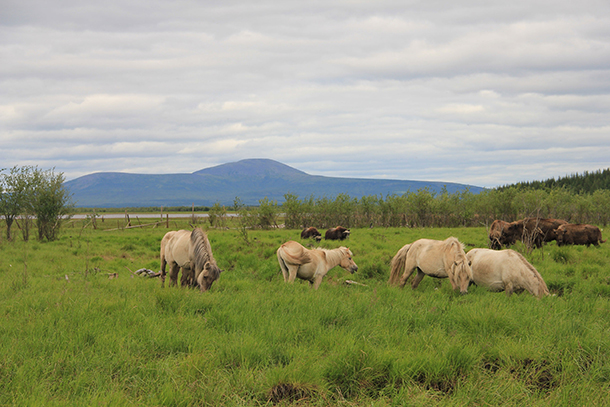
Yakutian horses, musk ox, and bison graze on the lush summer grasses at Pleistocene Park. (Photo: Pleistocene Park Kickstarter page)
CURWOOD: Melting permafrost isn’t just happening in North America, but on the other side of the Arctic, in Siberia as well. And the warming there has inspired an intriguing proposal based on the idea that restoring a "lost" ecosystem could hold the key to slowing down the thaw. Living on Earth’s Jenni Doering has the story.
DOERING: Siberia’s permafrost is gradually disappearing, and it’s not going quietly.
[METHANE EXPLOSION SOUND]
DOERING: It might make you imagine a jet engine, but it’s actually roaring methane set on fire as it leaks from a melting bubble. Methane that’s a remnant of the frozen landscape that was here thousands of years ago.
ZIMOV: [SOUND OF WAVES] During the Ice Age, millions of animals roamed this territory.
DOERING: That’s Russian scientist Nikita Zimov, who lives in the far north of Siberia. At the seashore of the Arctic Ocean, where the permafrost is thawing, he pulls the remnants of these animals, like mammoth tusks, out of the mud.
ZIMOV: In places where permafrost is eroded, we often discover bones of animals.
DOERING: Nikita says these are the remains of a lost ecosystem, the end of the last Ice Age. His geophysicist father, Sergey, wants to re-create that ecosystem in Pleistocene Park. It’s an idea that captured the imagination of an independent film-maker.
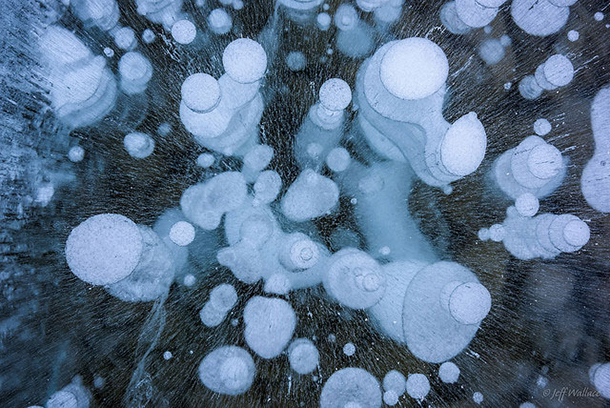
Frozen methane bubbles. (Photo: Jeff Wallace, Flickr CC BY-NC 2.0)
GRISWOLD-TERGIS: My name is Luke Griswold-Tergis. I’m making a documentary about Sergey Zimov. He wants to use the animals that are available today, bring this ecosystem back, restore its function, and he thinks by doing this he can prevent permafrost from melting.
DOERING: This remote and desolate corner of Siberia lies a couple of hundred miles north of the Arctic Circle. Wintertime temperatures average 27 degrees below zero Celsius. In Fahrenheit that’s about 17 below. But this frigid landscape is warming, an ominous sign for many scientists, such as Ted Schuur, a permafrost expert at Northern Arizona University.
SCHUUR: If we focus on the models that use the scenario of what we call, “the business as usual,” kind of the current human emissions of greenhouse gases,” we find that much of the surface permafrost, the top three meters of the soil, might disappear by the end of the century.
DOERING: That top three feet alone is estimated to contain twice as much carbon as what’s already in Earth’s atmosphere, and, as it’s released over the coming decades, scientists say it could spell climate disaster. Nikita Zimov believes he knows how to thwart that.
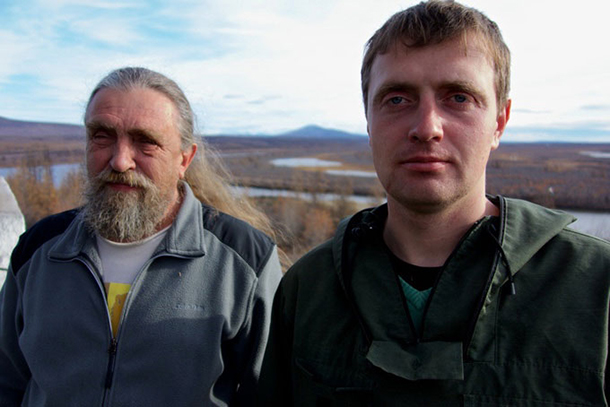
Sergey Zimov, left, and his son Nikita. (Photo: Pleistocene Park Kickstarter page)
ZIMOV: There is only one theoretical chance to prevent that from happening. We must restore the Ice Age ecosystem.
DOERING: At Pleistocene Park, near the crumbling, mostly abandoned Soviet-era town of Cherskiy, the Zimovs have begun the process of restoration by bringing in some climate-adapted species, like stocky, local Yakutian horses, muskox, and wisents, or European bison. Reindeer, elk, and moose were already there, although in low numbers.
[RUMINANT MUNCHING SOUNDS (Felix Blume, Freesound.org, Uploaded August 18, 2013)]
DOERING: The idea is that through the routine action of grazing and trampling the snow, these animals could lower the temperature of the ground.
GRISWOLD-TERGIS: In the wintertime, you have basically a meter-thick layer of snow. Kind of like, imagine it’s a cold night and you go to sleep outside and you put a down comforter over you, and you’re warm, like your body is warm, the air is cold, and the comforter insulates you from that cold air. So the snow is the same thing and I know this is counterintuitive, but it’s like a down comforter. It’s thick and fluffy and covers the ground and keeps the ground warmer.
DOERING: That’s where the horses, muskox, and bison come in, says Nikita Zimov.
ZIMOV: So, when animals trample down the snow they actually thin that layer of snow, making it dense, and this allow much deeper freezing during winter.

Pleistocene Park is located in the far north of Siberia, near Cherskiy. In this satellite image, the many small “thermokarst” lakes that form when permafrost melts are visible. (Photo: Pleistocene Park Kickstarter page)
DOERING: Although the Zimovs’ research is still ongoing, early comparisons of soil temperatures below the compacted snow and ungrazed terrain indicate that all that trampling does cool the ground. And other research supports the basic idea. In Alaska, Ted Schuur is studying the insulating effect of snow on permafrost.
SCHUUR: We’re creating an experiment where we cause the permafrost to thaw, so we want to simulate a future warmer world. We build these fences which are called snow fences, and they cause a drift of snow to pile up behind the fence. So we actually create this thicker layer of snow on the tundra behind these fences, and that has the effect of keeping the tundra warmer, and it starts to degrade the permafrost.
DOERING: So, in wintertime, by thinning the blanket of snow, Zimov’s animals give the way-below-freezing Siberian air better access to the ground, so the permafrost stays colder. Schuur guesses that putting grazing animals back on the landscape, however, might have unanticipated effects.
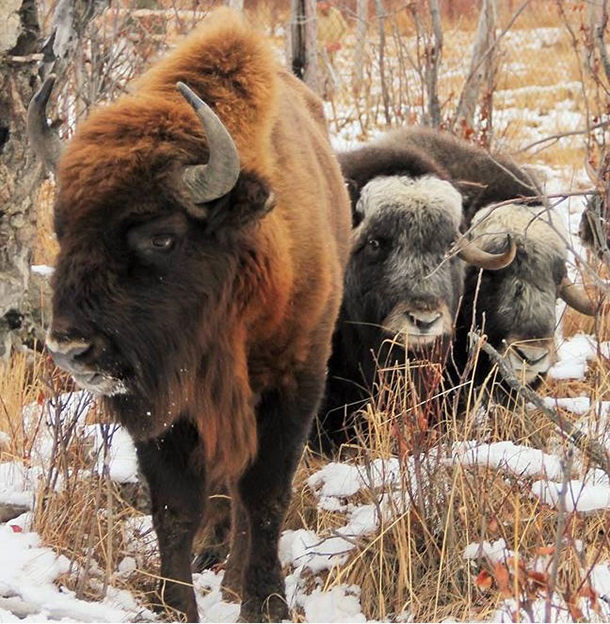
The Zimovs have also brought wisents, or European bison (the animal in the foreground), and musk oxen to Pleistocene Park to help re-create the ice age “mammoth steppe” ecosystem. (Photo: Pleistocene Park Kickstarter page)
SCHUUR: Animals would also be there in the summertime, and another possible effect of increasing your animals is that they might disturb the moss and soil organic layer that exists on top of the active layer. And in the summertime that has sort of the opposite effect. If you disturb the surface layer, it actually exposes the permafrost to warm summer temperatures.
DOERING: In the process of filming Pleistocene Park, Luke Griswold-Tergis also wondered about warmer summer temperatures without the insulating moss and shrubs, but says the Zimovs have an answer.
GRISWOLD-TERGIS: The summer is only three months long, and the winter is nine months long, and the winter is colder than the summer is warm, so their explanation is that the effect of removing winter snow is greater than the effect of removing summer insulation, and that the temperature of permafrost will be lower, and therefore it’ll be more stable.
DOERING: The Zimovs also hope that the part of the permafrost known as the active layer, just underneath the moss, would star in another climate-friendly outcome of their experiment. They say the grazers would help sequester carbon, by stimulating the growth of grasses that take carbon dioxide from the atmosphere and return it to the soil. Currently, grasses grow slowly there, says filmmaker Luke Griswold-Tergis.
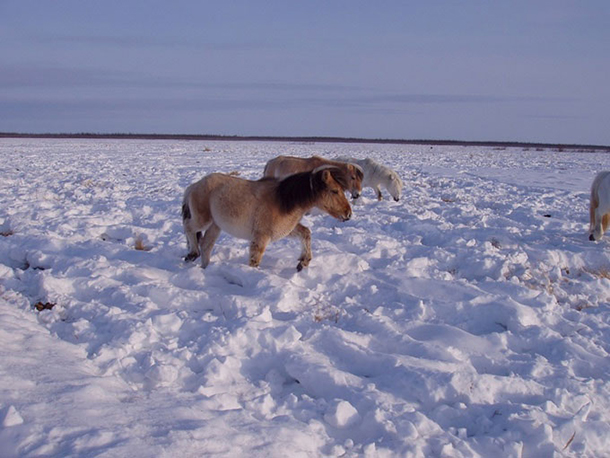
Yakutian horses are a semi-wild breed that have an extra-long and thick coat suited for Siberia’s frigid winter temperatures. Here, they trample down the insulating snow. (Photo: Pleistocene Park Kickstarter page)
GRISWOLD-TERGIS: But if a horse or a bison or a mammoth comes along and eats a blade of grass, that grass goes directly into this 37 degree fermentation vat full of microbes that digest it really quickly, like in a matter of hours to days kind of timeframe, and it returns to the landscape in the form of urine or feces, which fertilize more plants.
DOERING: When they roamed these vast steppes, mammoths would have contributed a lot to this fertilization. Their elephant cousins produce over 100 pounds of manure a day. There are efforts underway to bring back the woolly mammoth with genetic engineering, but whether that’s possible is unknown.
GRISWOLD-TERGIS: Well, Sergey is kind of...he would love to have a woolly mammoth. At the same time he wants to proceed with this, with or without a woolly mammoth, and he wants to use animals that are available now. And his son Nikita is also super pragmatic. I think Nikita said to me, he’s, like, “I don’t care whether it has five legs or six legs, I just care that it eats the grass and cycles nutrients and reproduces and can survive an Arctic winter."
DOERING: Another thing that works? An old Soviet army tank. Nikita drives it around, and its caterpillar treads flatten the snow and snap young larch trees, simulating the heavy footsteps of the huge woolly mammoths that once ruled this land. Nikita Zimov again.
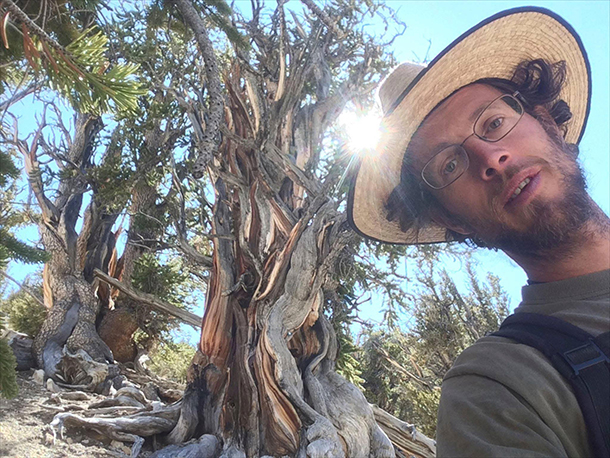
Luke Griswold-Tergis is an independent filmmaker whose previous film was “Smokin’ Fish." (Photo: Luke Griswold-Tergis)
ZIMOV: We’ve been hearing talks about global warming for decades, but still problem gets only worse. In place where I live, changes become evident to everybody. We are rapidly approaching tipping point, when warming becomes unstoppable. It is too late to wait for someone else to deal with it. We must take actions now.
DOERING: In a bid to build up their herds, the Zimovs have launched a Kickstarter campaign. And if that succeeds, and they’re proven right, then this remote, isolated corner of the Earth could help safeguard the rest of the world.
For Living on Earth, I’m Jenni Doering.
Related links:
- About Pleistocene Park
- Harvard Woolly Mammoth Revival project
- About Luke Griswold-Tergis
- BBC: Siberia’s thawing permafrost is creating massive ‘craters’ in the land
- Professor Ted Schuur’s lab
[MUSIC: Kalichstein/Laredo/Robinson Trio, ”Modere” from “Trio in a-minor” on Ravel: Works For Piano, Violin, & Cello, Maurice Ravel, Koch International.]
Mallards Brave New England’s Winter Surf
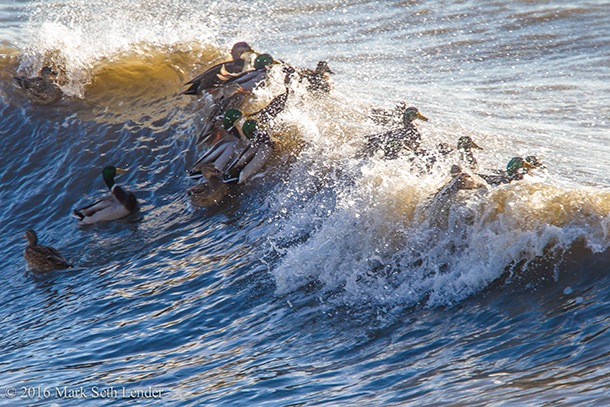
The mallards brave the foaming waves at the shore, even in winter (Photo: Mark Seth Lender)
CURWOOD: It may have been relatively warm up in far northern latitudes, but in New England, especially along the coastline, there’s been a fair share of cold and storms and blizzards. That may have tempted many of us to huddle ‘round the fire, but our resident explorer, Mark Seth Lender, has been observing wintering mallards, who’ve been having a tough time.
[SOUNDS OF DUCKS AND CRASHING WAVES]
LENDER: The weather has it in for them. Mostly the wind and the waves that follow auguring no good thing to come. There will be storms. And here, in the shallows where the surface tears itself apart, no leaning to, no calm. For the mallards, no respite anywhere.

A mallard preening. (Photo: Mark Seth Lender)
The sea rolls, high and hard breaking. They stoop, low, and pull through the tumult and the roar, in a backlit spray of water. Tipped, like so many listing ships. Before they can right themselves the swell picks them up once more, and the ocean pours over them. In the spitting, the white rasping anger of the sea they bob and dip and tuck themselves in. And the water, a horizontal waterfall, tosses and toys with them like sticks, like sodden leaves, not live and feeling things, chasing, racing, crowding them towards shore.
But shore is not what they want. They cleave instead to a middle ground, between rough water and the sand. They hover, as best they can, above the rocks where the weed is green and crusted with tiny and delicious things, to nourish against this hard time of the year. Against their will they are carried away and cannot feed because they cannot hold there, and the cold bores into them.
And again they rove through the rough and the roar and the shirring foam. They shake their heads and face into the wind.
Mallards leave the water for the air at as hard an angle as flight will sustain towards the fog-bound sun. Then wheel and glide, their back-peddling wings like feathered oars. And down onto the sand. They shrug, the drakes, their heads bright green and violet glistening. That patch of purple-blue like semaphore on the hens’ drab flanks.
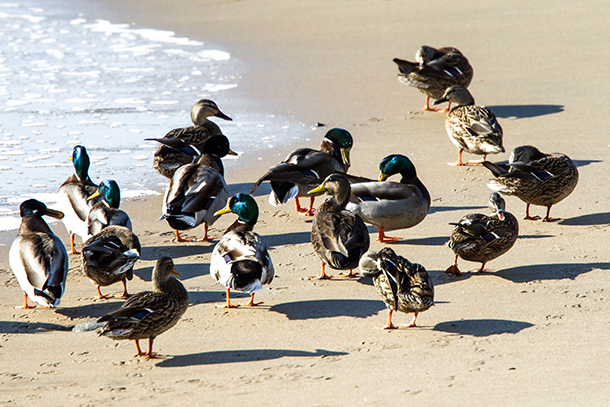
The mallards escape the punishing surf and waddle inland (Photo: Mark Seth Lender)
They turn, their flight feathers tucked around their shoulders, and trudge inland.
[WAVES CRASHING, MALLARDS QUACKING]
CURWOOD: Mark recorded the waves and these hardy mallards. You’ll find some photos at our website, LOE.org.
[MUSIC: Paul Winter Consort, “Icarus” https://www.youtube.com/watch?v=xbGGIBTnCXA]
CURWOOD: Next time on Living on Earth, the president promises the Keystone pipeline will guarantee American energy security. But opponents say that’s not true.
KLEEB: This pipeline would open up a huge superhighway to export tar sands to the export market. This is not about, you know, providing tar sands to America.
CURWOOD: The hurdles still facing Keystone XL. And that’s next time, on Living on Earth.
Related links:
- Stewart McKinney National Wildlife Refuge
- Mark Seth Lender's website
[MUSIC: Paul Winter Consort and Friend, “Icarus” on Earthdance, Ralph Towner, A&M Records]
CRWOOD: Living on Earth is produced by the World Media Foundation. Our crew includes Naomi Arenberg, Bobby Bascomb, Savannah Christiansen, Jenni Doering, Noble Ingram, Jaime Kaiser, Don Lyman, Alex Metzger, Kit Norton, Helen Palmer, Adelaide Chen, and Jolanda Omari. Tom Tiger engineered our show, with help from Jake Rego. Alison Lirish Dean composed our themes. You can hear us anytime at LOE.org - and like us, please, on our Facebook page –it’s PRI’s Living on Earth. And we tweet from @LivingOnEarth. I'm Steve Curwood. Thanks for listening.
ANNOUNCER1: Funding for Living on Earth comes you, our listeners, and from the University of Massachusetts, Boston, in association with its School for the Environment, developing the next generation of environmental leaders. And from the Grantham Foundation for the protection of the environment, supporting strategic communications and collaboration in solving the world’s most pressing environmental problems. Support also comes from the Energy Foundation, serving the public interest by helping to build a strong, clean, energy economy, from Carl and Judy Ferenbach of Boston, Massachusetts and from SolarCity, America’s solar power provider. SolarCity is dedicated to revolutionizing the way energy is delivered by giving customers a renewable alternative to fossil fuels. Information at 888-997-1703. That’s 888-997-1703.
ANNOUNCER2: PRI. Public Radio International.
Living on Earth wants to hear from you!
Living on Earth
62 Calef Highway, Suite 212
Lee, NH 03861
Telephone: 617-287-4121
E-mail: comments@loe.org
Newsletter [Click here]
Donate to Living on Earth!
Living on Earth is an independent media program and relies entirely on contributions from listeners and institutions supporting public service. Please donate now to preserve an independent environmental voice.
NewsletterLiving on Earth offers a weekly delivery of the show's rundown to your mailbox. Sign up for our newsletter today!
 Sailors For The Sea: Be the change you want to sea.
Sailors For The Sea: Be the change you want to sea.
 The Grantham Foundation for the Protection of the Environment: Committed to protecting and improving the health of the global environment.
The Grantham Foundation for the Protection of the Environment: Committed to protecting and improving the health of the global environment.
 Contribute to Living on Earth and receive, as our gift to you, an archival print of one of Mark Seth Lender's extraordinary wildlife photographs. Follow the link to see Mark's current collection of photographs.
Contribute to Living on Earth and receive, as our gift to you, an archival print of one of Mark Seth Lender's extraordinary wildlife photographs. Follow the link to see Mark's current collection of photographs.
 Buy a signed copy of Mark Seth Lender's book Smeagull the Seagull & support Living on Earth
Buy a signed copy of Mark Seth Lender's book Smeagull the Seagull & support Living on Earth

